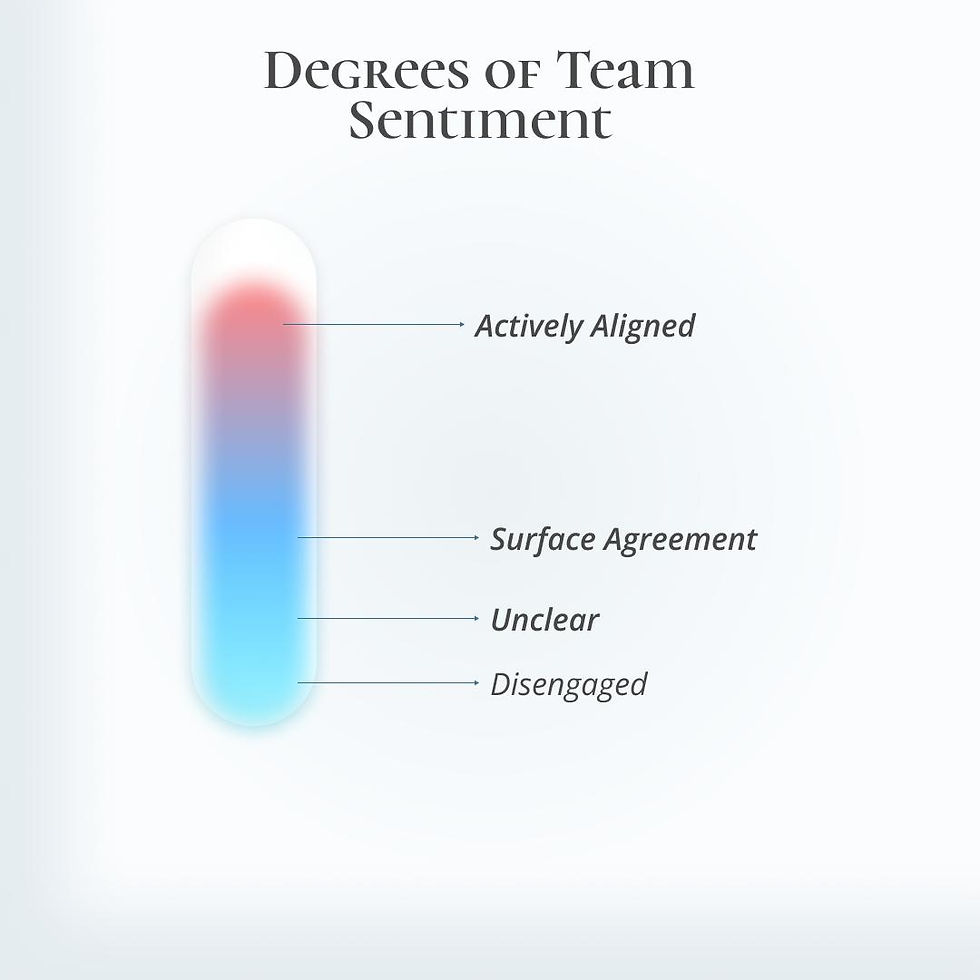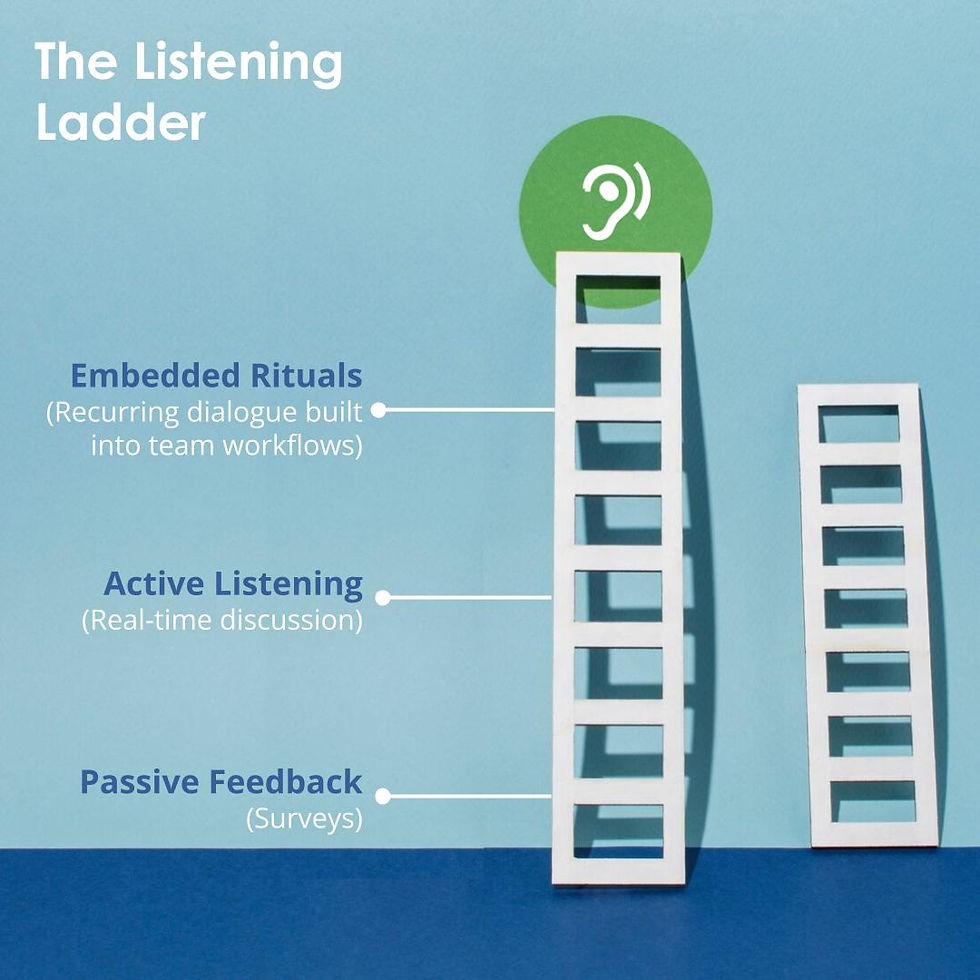The Temperature Trap: What Leaders Miss When They Misread the Room
- C-Suite Coach

- Jul 28
- 5 min read
Updated: Aug 4
In leadership, few things are more frustrating than putting time and effort into creating a moment of alignment, only to find out later that it didn’t land the way you thought. Imagine a manager planned what they believed was a thoughtful team meeting following a departmental reorg. There was a clear agenda, open Q&A, and even a breakout activity to build buy-in. People smiled, nodded, and engaged just enough to suggest things were on track. But within a couple of weeks, two high-performing team members resigned. During their exit interviews, both shared a similar sentiment: “I didn’t feel seen or heard in the process.”
The manager wasn’t careless or indifferent, in fact, they believed they were leading with intention. But they missed a critical leadership competency: accurately reading the emotional and relational temperature of the team. It’s what we call the temperature trap, when leaders mistake polite agreement for genuine alignment and lose out on the feedback, trust, and cohesion required to move forward successfully.
Understanding how to take the true temperature of your team is essential to leading in a way that builds momentum instead of confusion, and long-term retention instead of avoidable turnover.
Misreading the Room Isn’t Just a Soft Issue
The cost of misreading the emotional state of your team creates more than hurt feelings. It can quietly erode engagement, productivity, and retention.
According to Gallup’s State of the Global Workplace 2023 report, only 23% of employees globally are engaged at work, while 59% report being “quietly disengaged,” going through the motions without real investment in outcomes (Gallup, 2023). When that kind of disengagement festers beneath the surface, even seemingly positive moments, like offsites, summits or town halls, can become missed opportunities for course correction and culture-building.
Another study from McKinsey & Company found that a top reason employees quit is due to “uncaring and uninspiring leaders,” second only to lack of career advancement (McKinsey, 2023). When employees feel their point of view doesn’t matter, they eventually stop offering it. And when they stop offering it, trust begins to decay.

Why It Happens More Than You Think
Misreading the room happens most often when teams are under pressure or moving quickly. Managers and senior leaders are often juggling competing priorities and may unintentionally rely on surface cues, such as head nods or lack of direct complaints, to gauge team alignment. But silence isn’t always consent. In some cases, it’s a sign of discomfort, fear, or confusion. In The Five Dysfunctions of a Team, Patrick Lencioni describes this phenomenon as “artificial harmony,” which occurs when a group avoids productive conflict in favor of a fragile peace. This false sense of cohesion can prevent the kind of open dialogue and trust that real collaboration requires.
It’s also common for feedback systems to break down at higher levels of seniority. Senior leaders may assume that managers are gathering accurate input, and managers may assume that their teams would speak up if something felt off. Without intentional check-ins and structured feedback opportunities, these assumptions can lead to blind spots that grow more damaging over time.
How to Take a More Accurate Temperature
The good news is that building an accurate read of your team’s emotional and strategic alignment is completely learnable. It starts with small but intentional habits that create space for honesty, clarity, and follow-through.
For people managers, this means developing feedback rituals. Start by implementing simple post-meeting pulse checks, where you ask questions like, “What felt useful in today’s meeting?” or “What still feels unresolved?” This not only helps you clarify key messages, but also builds a culture where employees expect to be heard. Nonverbal cues also matter. If team members are suddenly quieter, show less curiosity, or skip optional meetings, those behaviors may signal more than just workload, they could be signs of quiet withdrawal.
For senior leaders, the task is to make sure honest input is flowing through the organization and this requires more than an open-door policy. It may involve scheduling regular skip-level conversations, creating anonymous channels for suggestions, or using trained coaches or facilitators to conduct listening sessions. The key is to reduce the distance between leadership assumptions and frontline experiences.

Leading at Every Level
Whether you manage a five-person team or sit at the helm of a 500-person organization, the cost of misreading your employees is the same: misalignment, mistrust, and missed opportunity, which can lead to turnover.
When managers develop the skills to create trust and psychological safety, team members are more likely to offer real-time insights and ask hard questions. And when senior leaders make space for honest feedback loops, managers feel supported in creating a culture of candor and care.
At C-Suite Coach, we support both managers and executives in building systems that turn feedback into action. That’s where alignment starts and performance follows. Trust is not built by always getting it right, but by consistently showing a willingness to ask, listen, and adjust.
Moving Forward with Intention
If you're ready to check the temperature in your team with more precision, start by introducing a simple but consistent “pulse check” habit this month. This could be as quick as a two-question survey, a standing agenda item in your weekly team meeting, or a round of reflective feedback during your next 1:1s. The goal isn’t to collect perfect data, it’s to create a reliable cadence and a sense of psychological safety around honest reflection. Over time, you’ll find that these small check-ins build trust, surface valuable insights, and help you stay ahead of potential challenges before they escalate, because when reflection becomes routine, alignment becomes easier to maintain, and your team becomes more resilient, connected, and equipped to move forward with clarity.

Ready to bring this practice into your team culture? Let C-Suite Coach help you design a pulse strategy that fits your goals and meets your team where they are.

C-Suite Coach is the preferred strategic partner in talent development and business solutions. We are dedicated to helping your organization build a trusted workplace while cultivating a thriving culture. Submit a consultation request here to learn more about our services.
.png)



Comments